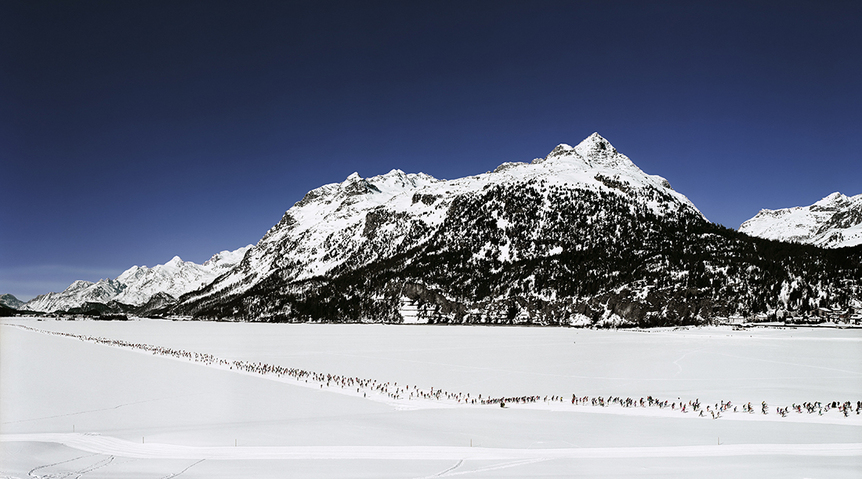
R
E
V N
E
X
T
Over a decade ago, I had my first encounter experiencing the large-scale works of German photographer Andreas Gursky. It was disorienting—I felt as if my entire being was drawn into the artwork by a powerful force—and there were so many details to be discerned in each image, which only fueled my fascination further. Gursky’s gigantic photographs, some of them up to two meters high and three meters long, had the presence and the stylistic power of 19th century landscape paintings, without losing any of their meticulous details and immediacy as photographs. On view currently at New York’s Parrish Art Museum is a career survey titled “Landscapes" featuring 19 of Gursky’s photographs from the 1980s to the present day.
Gursky was born in 1955 in Leipzig, in former East Germany. He studied under collaborative artist and photographer duo Bernd and Hilla Becher at the Kunstakademie Düsseldorf in the early 1980s and began adopting a style and method closely following Becher’s systematic approach to photography, creating small black and white prints. After setting up a color darkroom with friends, he broke from traditional monochrome and began using color film to explore juxtapositions of nature and the automotive industry in the German Ruhr Valley, producing a series of images rendering clusters of people engaged in leisurely activities out in the open landscape. In the late 1980s through to the 90s, Gursky’s work adopted an increasingly global range of subjects, and he presented his images on an even bigger format than previously. From the vast, anonymous architecture of modern day hotel lobbies, supermarkets, apartment complexes and warehouses to stock exchanges and parliamentary buildings in cities such as Shanghai, Brasilia, Los Angeles and Hong Kong, the resulting bodies of works from this period took on a thematic and critical study into the effects of globalization on contemporary life.
In the 1990s Gursky was using the greatest size of photographic paper on the market; by 2000 he was combining sheets to produce images exceeding two meters in height and nearly four and a half meters in width. It was at this time that Gursky also began to use digital technology, retouching his images and altering his negatives. For some photographs featuring an architectural subject, such as Paris, Montparnasse (1993), he moved the camera, panning shots of an apartment complex, then combined the negatives on a computer to make a seamless, panoramic image. The photograph portrays the building in more distinct details than one could see with the naked eye. In the countless windows of each apartment, different scenarios are occurring, which raises one’s level of curiosity and attention thus serving to detract from the uniform and grid-like monotonous facades of the real apartment complex.
Gursky has never concerned himself with the notion of the “authentic photo”—the idea that photography is to present reality as it is. Although a sense of impersonality seems to run throughout his work, it is a necessary component for Gursky seeks the perspective of an outside observer and does not participate in the events of his photographs. With an unfailing eye for grand architectural structures, Gursky’s notion of reality is the result of the construction of his picture, by compacting space and time in his images, he is showing us the world not as it is, but his own version of it. To this end, Gursky always takes his pictures from a vantage point that is out of the ordinary—from a bird’s eye view perspective. He goes to extraordinary trouble to get his images, from seeking permission for rooftops and climbing balconies, to shooting from lift trucks and cranes, and ever more frequently in recent years, shooting from helicopters.
In the late 1980s, when Gursky was gaining popularity, photography was also first entering gallery spaces, and photographs were taking their place alongside paintings. So it is quite remarkable that just over two decades later, on November 8, 2011, one of Gursky’s works photographing the River Rhine, titled Rhein II (1999), was sold for USD 4.3 million dollars at Christie’s New York. This marked the highest price ever paid for a photograph, surpassing the other record sale four years earlier of perhaps one Gursky’s most iconic images, 99 Cent II Diptychon (2001), a colorful depiction of a supermarket interior with aisles upon aisles of products on display. The diptych was sold at Sotheby’s London fetching USD3.34 million.
At the Parrish Art Museum, viewers who are not familiar with Gursky’s oeuvre will now have a chance to not only see it, but also experience the spectacularly detailed energy of the photographs. The large structures employed by Gursky give his photographs their footing, and the details give them their life. His work allows viewers to soak up and take in more than their eyes are capable of, and most importantly, the need for us to recognize their underlying symbolic nature of both our contemporary life and the essential embrace of classical structure and order.
Billy Kung is photo editor at ArtAsiaPacific.



